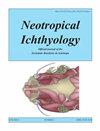A new species of barred Sternopygus (Gymnotiformes: Sternopygidae) from the Orinoco River
IF 2
4区 生物学
Q1 ZOOLOGY
引用次数: 1
Abstract
Abstract A new species of Sternopygus is described from the Orinoco River of Venezuela using traditional methods of morphometrics and meristics, and micro-computed tomography (micro-CT) imaging for osteological analysis. The new species is readily separated from all congeners in having broad, vertical pigment bars that extend from the mid-dorsum to the ventral margin of the pterygiophores. A similar color pattern, characterized by subtle differences in the densities and sizes of chromatophores, is also present in juveniles of S. obtusirostris from the Amazon River, juveniles of S. sabaji from rivers of the Guiana Shield, and S. astrabes from clearwater and blackwater terra firme streams of lowlands around the Guiana Shield. The new species further differs from other congeners in the Orinoco basin by having a reduced humeral pigment blotch with poorly defined margins, a proportionally smaller head, a longer body cavity, a more slender body shape in lateral profile, and in having vertical pigment bars that extend ventrally to the pterygiophores (vs. pigment saddles not reaching the pterygiophores). The description of this species raises to three the number of Sternopygus species in the Orinoco basin, and to 11 the total number of Sternopygus species.文章标题奥里诺科河斑胸蟹一新种(裸子目:胸蟹科)
摘要利用形态计量学和统计学的传统方法,以及显微计算机断层扫描(micro-CT)成像技术对委内瑞拉奥里诺科河的一种新种胸骨龙进行了描述。这个新种很容易与所有同类区分开来,因为它有宽的、垂直的色素条,从翼状细胞的中背延伸到腹缘。在亚马逊河的S. obtusirostris幼鱼、圭亚那地盾河的S. sabaji幼鱼和圭亚那地盾周围低地的清水和黑水陆地溪流中的S. astrabes幼鱼中也存在类似的颜色模式,其特征是色素体的密度和大小存在细微差异。这个新物种与奥里诺科河盆地的其他同类物种的进一步不同之处在于,它的肱骨色素斑点减少,边缘不清晰,头部相对较小,体腔较长,侧面轮廓较细长,并且具有垂直的色素条,延伸到腹侧的翼状细胞(相对于色素鞍不到达翼状细胞)。对这一物种的描述使奥里诺科河流域胸腹鱼的种类增加到3种,使胸腹鱼的总种类增加到11种。
本文章由计算机程序翻译,如有差异,请以英文原文为准。
求助全文
约1分钟内获得全文
求助全文
来源期刊

Neotropical Ichthyology
生物-动物学
CiteScore
2.80
自引率
17.60%
发文量
24
审稿时长
6-12 weeks
期刊介绍:
Neotropical Ichthyology is the official journal of the Sociedade Brasileira de Ictiologia (SBI). It is an international peer-reviewed Open Access periodical that publishes original articles and reviews exclusively on Neotropical freshwater and marine fishes and constitutes an International Forum to disclose and discuss results of original research on the diversity of marine, estuarine and freshwater Neotropical fishes.
-Frequency: Four issues per year published only online since 2020, using the ‘rolling pass’ system, which posts articles online immediately as soon as they are ready for publication. A searchable and citable Digital Object Identifier (DOI) is assigned to each article immediately after online publication, with no need to await the issue’s closing.
-Areas of interest: Biology, Biochemistry and Physiology, Ecology, Ethology, Genetics and Molecular Biology, Systematics.
-Peer review process: The Editor-in-Chief screens each manuscript submitted to Neotropical Ichthyology to verify whether it is within the journal’s scope and policy, presents original research and follows the journal’s guidelines. After passing through the initial screening, articles are assigned to a Section Editor, who then assigns an Associate Editor to start the single blind review process.
 求助内容:
求助内容: 应助结果提醒方式:
应助结果提醒方式:


